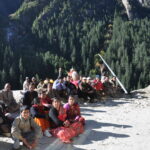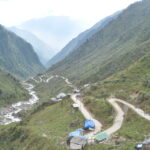VALLEY Of FLOWERS – HEMKUND SAHIB
Overview
Valley of Flower – Hemkund Sahib Tour Package Itinerary : – Delhi – Rishikesh – Joshimath – Govind Ghat – Valley of Flower – Ghangaria – Hemkund Sahib – Srinagar – Haridwar
In Rigveda the traditional name of Garhwal was Kedarkhand means “the land of God” and ‘DEVBHOOMI”. The only source of history of this region is religious texts, that is why this period is also called PURANIC PERIOD. Joshimath: The religious centre, established by Adi Shankaracharya, which he called Jyotirmath, later known as Joshimath. known for its scenic beauty. Visit the foothills of Govind Ghat to pilgrim trail Ghangaria- while experiencing some charming sight :Valley of Flowers. Impressive array of rare wildflowers like Geranium, Marsh marigold, Prinula, Potentilla, Geum, Asters, Lilium, Ranunculus, Corydalis, Inula, Braham kamal, Campanula, Pedicularis, Arisaema, Epilobium, Rhododendrons and numerous others. Most of the flowers have medicinal values . Admire the an impressive array of. Hemkund Sahib. In the Sikh holy book, “The Guru Granth Sahib”, the Sikh Guru Gobind Singh recounts that in a previous life, he meditated on the shores of a lake surrounded by seven snowcapped mountains now recognized as Hemkund Sahib. Not to forget largest dam in the world is Tehri Dam in Tehri GARHWAL!





DELHI - RISHIKESH
In the morning drive towards Rishikesh via Haridwar. On arrival check in to the hotel. By evening one can go for the Aarti ceremony at Ganga Ghat. Overnight at the hotel.
RISHIKESH - JOSHIMATH
After an early breakfast drive to Joshimath via DevPrayag On the way visit DevPrayag where Bhagirathi and Alaknanda rivers meet. From here the holy river Ganges started. Arrival at Joshimath by evening, check into the hotel. Dinner & overnight stay. Joshimath: The religious centre, established by Adi Shankaracharya, which he called Jyotirmath, later came to be known as Joshimath. Among the sites of interest are the temples of Nav Durga and Narsingh. Apart from its obvious religious importance, Joshimath is known for its scenic beauty. Overnight at the hotel.
JOSHIMATH – GOVIND GHAT
After an early breakfast drive to Govind Ghat. Which is the starting point of the trek? From Govind Ghat there is a gradual ascent along a well maintained pilgrim trail to Ghangaria. Upon arrival at Ghangaria check into Camp. Explore the surroundings in the evening. Overnight at camp.
GHANGARIA - VALLEY OF FLOWERS
After breakfast, trek to Valley Of Flowers (3858 m) from Ghangaria. The valley is an enchanting sight with an impressive array of rare wildflowers like Geranium, Marsh marigold, Prinula, Potentilla, Geum, Asters, Lilium, Ranunculus, Corydalis, Inula, Braham kamal, Campanula, Pedicularis, Arisaema, Morina, Impatiens, Bistorta, Ligularia, Anaphalis, Saxifrages, Sibbaldia, Thermo- psis, Trollius, Codonopsis, Dactylorhiza, Cypripedium, Strawberry, Epilobium, Rhododendrons and numerous others. Most of the flowers have medicinal values too. The valley is 10 kms long, 2 kms wide, and is divided by the Pushpawati stream, into which several tiny streams and waterfalls merge. After enjoying the beauty of the valley, trek back to Ghangaria. Overnight at camp.
GHANGARIA - HEMKUND SAHIB - GHANGARIA
After breakfast, trek to Hemkund Sahib (4329 m) from Ghangaria. This is quite a steep climb. In the Sikh holy book, The Granth Sahib, the Sikh Guru Gobind Singh recounts that in a previous life, he meditated on the shores of a lake surrounded by seven snowcapped mountains now recognized by Hemkund. Late afternoon trek back to Ghangaria. Overnight at camp.
GHANGARIA - GOVIND GHAT - SRINAGAR
After breakfast, trek down to Govind Ghat and from here drive to Joshimath. Overnight at the hotel.
SRINAGAR - HARIDWAR – DELHI
In the morning drive to Delhi via Rishikesh. Arrival at Delhi by late evening. Trip & Services End Here.
